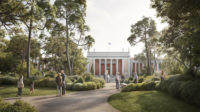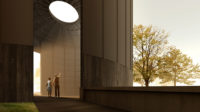Construction is scheduled to begin this fall on a center conceived by the late Senator Edward Kennedy to teach students about the inner workings of government.
On July 28, the Edward M. Kennedy Institute for the United States Senate finally unveiled the design of its forthcoming home, to be built on the Boston waterfront alongside the John F. Kennedy Presidential Library and Museum. The $60 million project, designed by Rafael Viñoly Architects, is slated to be finished in 2013.
Click on the slide show icon to see additional photos.
Viñoly won a competition to design the building last year. Although the firm’s selection wasn’t publicly announced, Senator Kennedy was apprised of the decision before he died on August 25, 2009, from brain cancer, at the age of 77, according to an institute spokesman.
While its exact size is not yet final, the building will include 40,000 square feet of public space, says Viñoly architect Martin Hopp, the project’s director. A replica of Kennedy’s Capitol Hill office, with his desk and framed pictures, will be featured inside. The facility will also contain classrooms, galleries, and a scaled-down replica of the Senate chamber. These elements elevate the project beyond mere memorial status, says Hopp, adding, “we’re excited about the civic role this building will play.”
The selection of Viñoly was made by the University of Massachusetts, which owns the institute’s two-acre site. With large basic geometric forms and cast-concrete walls, the building will strongly echo its next-door neighbor, the Kennedy library, whose cylinder-and-wedge contours were created by I.M. Pei in 1979. Also near the site are a handful of mostly brick buildings that are part of the university’s 160-acre campus.
The low-slung institute will sit the end of an entrance path likely suspended on a bridge and lined by 25 glass posts per side, to represent the 50 U.S. states, Hopp says. Visitors will enter a skylight-topped atrium, which will lead to a central gallery. Cafes will occupy triangular corner sections, Hopp adds, while classrooms will ring the perimeter.
And though the simulated Senate chamber will offer modern flourishes, like desks fitted with computers, it will contain 100 seats—two for every state—like its Washington, D.C., counterpart.
“If we do this correctly, you will have a Senate-like experience,” says Peter Meade, president of the institute, which was founded in 2003. Kennedy, whose 46-year congressional tenure made him the fourth-longest-serving Senator ever, wanted to encourage young people give public service a try, Meade adds.
Since fundraising for the project began in 2009, the institute has collected $88 million, from both individuals and the government, toward a goal of $100 million, which would cover construction and operating costs, Meade says.
The adjacent Kennedy library, meanwhile, is undergoing its own $22 million expansion. Construction is under way on a new 30,000-square-foot wing designed by Einhorn Yaffee Prescott Architecture and Engineering, based in Albany, New York.
David McKean, chief executive of the library’s foundation, says the new facility will complement what’s currently there, in terms of aesthetics and function. “We do a lot with younger kids, and they will bring in high-school kids,” McKean says, “so it will be a pretty interesting combination of exhibits and opportunities.”






Post a comment to this article
Report Abusive Comment